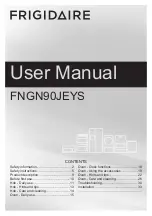
19
Meat, poultry, fish
Ovenware
You may use any heat
resistant ovenware. The baking tray is
also suitable for large roasts.
Glass ovenware is the most suitable. The lid of the roasting dish
should fit well and close properly.
Add a little more liquid when using enamelled roasting dishes.
With roasting dishes made of stainless steel, browning is not so
intense and the meat may be somewhat less well done.
Increase the cooking times.
Information in the tables:
Ovenware without a lid = uncovered
Ovenware with a lid = covered
Always place the ovenware in the centre of the wire rack.
Place hot glass ovenware on a dry mat after cooking. The glass
could crack if placed on a cold or wet surface.
Roasting
Add in a little liquid if the meat is lean. Cover the base of the
ovenware with approx. ½ cm of liquid.
Add liquid generously for pot roasts. Cover the base of the
ovenware with approx. 1 - 2 cm of liquid.
The amount of liquid depends on the type of meat and the
material the ovenware is made of. If preparing meat in an
enamelled roasting dish, it will need a little more liquid than if
cooked in glass ovenware.
Roasting dishes made from stainless steel are not ideal. The
meat cooks more slowly and browns less fully. Use a higher
temperature and/or a longer cooking time.
Tips for grilling
When grilling, preheat the oven for approx. 3 minutes, before
placing the food into the cooking compartment.
Always grill with the oven door closed.
As far as possible, the pieces of food you are grilling should be
of equal thickness. This will allow them to brown evenly and
remain succulent and juicy.
Turn the food you are grilling after
Z
of the time.
Do not add salt to steaks until they have been grilled.
Place the food to be grilled directly on the wire rack. If you are
grilling a single piece, the best results are achieved by placing
it in the centre of the wire rack.
Also insert the baking tray at level 1. The meat juices are
collected in the pan and the oven is kept cleaner.
When grilling, do not insert the baking tray or universal pan at
level 4 or 5. The high heat distorts it and the cooking
compartment can be damaged when removing it.
The grill element switches on and off continually. This is normal.
The grill setting determines how frequently this will happen.
Meat
Turn pieces of meat halfway through the cooking time.
When the roast is ready, turn off the oven and allow it to rest for
an additional 10 minutes. This allows better distribution of the
meat juices.
After cooking, wrap sirloin in aluminium foil and leave it to rest
for 10 minutes in the oven.
For roast pork with a rind, score the rind in a crossways pattern,
then lay the roast in the dish with the rind at the bottom.
The bread or cake (e.g. cheesecake)
looks good, but is soggy on the inside
(sticky, streaked with water).
Use slightly less fluid next time and bake for slightly longer at a lower temperature. For
cakes with a moist topping, bake the base first. Sprinkle it with almonds or bread crumbs
and then place the topping on top. Follow the recipe and baking times.
The cake is unevenly browned.
Select a slightly lower temperature to ensure that the cake is baked more evenly. Bake
delicate pastries on one level using
%
Top/bottom heating. Protruding greaseproof
paper can affect the air circulation. For this reason, always cut greaseproof paper to fit
the baking tray.
The bottom of a fruit cake is too light.
Place the cake one level lower the next time.
The fruit juice overflows.
Next time, use the deeper universal pan, if you have one.
Small baked products made out of yeast
dough stick to one another when bak-
ing.
There should be a gap of approx. 2 cm around each item. This gives enough space for
the baked items to expand well and brown on all sides.
Condensation forms when you bake
moist cakes.
Baking may result in the formation of water vapour, which escapes above the door. The
steam may settle and form water droplets on the control panel or on the fronts of adja-
cent units. This is a natural process.
Meat
Weight
Accessories and
ovenware
Level
Type of
heating
Temperature in
°C, grill setting
Cooking time
in minutes
Beef
Joint of beef
1.0 kg
Covered
2
%
200-220
120
1.5 kg
2
%
190-210
140
2.0 kg
2
%
180-200
160
Beef tenderloin
1.0 kg
Uncovered
2
%
210-230
70
1.5 kg
2
%
200-220
80
2.0 kg
2
%
190-210
90
Sirloin, medium rare
1.0 kg
Uncovered
2
%
210-230
60
Steaks, well-done
Wire rack
5
(
3
20
Steaks, medium rare 3 cm
Wire rack
5
(
3
15
















































